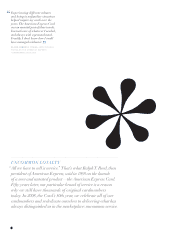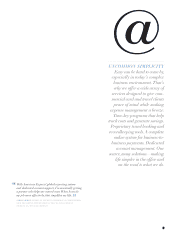American Express 2007 Annual Report Download - page 17
Download and view the complete annual report
Please find page 17 of the 2007 American Express annual report below. You can navigate through the pages in the report by either clicking on the pages listed below, or by using the keyword search tool below to find specific information within the annual report.LETTER TO SHAREHOLDERS
Despite the progress we made, our outlook for the short term changed at the end of the year. Declining
home values and spreading weakness in the U.S. credit markets—developments that we watched carefully
throughout the year—began to affect even affluent consumers. The December slowdown we experienced
in U.S. consumer spending was broad-based across all regions of the country. The rise in delinquencies
and loan write-offs in the latter part of the year was most pronounced in California, Florida, Nevada
and other areas of the country most affected by the housing slump. By the end of the fourth quarter,
delinquencies in the managed U.S. lending portfolio rose to 3.2 percent from 2.9 percent in the prior
quarter. The write-off rate rose to 4.3 percent from 3.7 percent for the same periods.*
In light of these trends, we took a $438 million credit-related charge against fourth-quarter earnings. This
action allowed us to raise worldwide lending reserves to 100 percent of past-due loans and to increase
reserve coverage in the charge card portfolio to 95 percent. While the charge reduced fourth-quarter
income from continuing operations, which was down 6 percent from a year ago, it has put us in an
appropriately stronger position for what we expect to be a more challenging 2008.
2008 OUTLOOK
In early January, amid clear signs that the U.S. economy was weakening, we announced our expectations
for slower growth in cardmember spending and weaker credit trends in the year ahead. These factors, we
said, would lead to slower growth in earnings per share in 2008 than we have generated in recent years.
Our planning assumptions were based on a moderate downturn in the U.S. economy and a more cautious
view of the business environment in the coming year. Of course, the situation is fluid and any significant
change in the economic and credit environment could alter our 2008 outlook.
Economists have differing views about the possible extent and timing of the current downturn and subse-
quent recovery. Regardless of how the economy may shift, we believe that the quality of our cardmember
base and the characteristics of our business model should help us to deal with the conditions better than
many of our competitors.
American Express is known for establishing relationships with prime and affluent customers. Even as we
grew lending balances significantly in 2007, we maintained our traditional credit standards and customer
focus. As a group, new cardmembers who joined American Express over the past year had credit scores and
other financial characteristics that are comparable to our existing base. And the diversity of that base, with
our mix of consumer and business-to-business customers and multiple products around the world, is
another positive factor in our performance.
Our business model is built on driving cardmember spending. Lending is a planned and profitable
outcome of our spend-centric strategy as we offer cardmembers the flexibility to revolve payments, but
it is not our primary focus. Moreover, our emphasis on developing rewards-based relationships typically
increases customer loyalty and improves credit performance. Because of this approach and our risk
management capabilities, our write-off and past-due rates have remained the lowest among all major
players in the industry using comparable methodology.
These characteristics work in our favor, but they surely do not insulate us from a more severe deterioration
in the economy. We are closely watching credit indicators, and while we are not making major changes
to our underwriting or authorization practices at present, we are making targeted credit line adjustments
where we see the greatest risk, tightening card approvals for certain segments and working with card-
members who may be having difficulty. Our objective, as always, is not solely to minimize loss rates but to
maximize long-term profitability by allowing good spending that will generate growth.
15
*
Managed basis assumes our cardmember loans have not been securitized. On a GAAP basis, delinquencies in the owned U.S. lending
portfolio rose to 3.5 percent in the fourth quarter from 3.1 percent in the prior quarter.
The write-off rate was identical on both a
managed and owned basis.
























